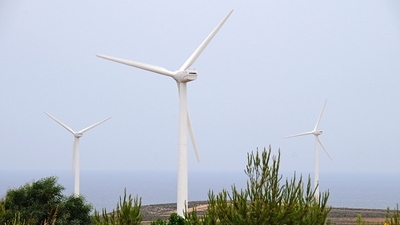Wind power is widely regarded as a key part of an environmentally sustainable, low-carbon energy future because it is fully renewable and involves near-zero emissions of greenhouse gases. Over the past 20 years, wind power has become the world’s fastest-growing source of electricity.
However, as with all large-scale sources of power generation, wind energy poses its own particular set of environmental challenges. For example, the inevitable visual impacts of large turbines across the landscape are widely recognized and sometimes controversial.
Less widely recognized, but potentially significant, are the adverse impacts that wind power facilities (turbines, new transmission lines, and access roads) can have on biodiversity.
Biodiversity Impacts
Even though wind power development overall might benefit biodiversity by reducing greenhouse gas emissions (thus potentially mitigating global climate change), land-based wind power facilities located in sensitive areas often harm birds, bats, and/or natural habitats.
Birds are killed by collisions with wind turbines as well as with the barely visible guy wires around meteorological towers. Although modern large turbine blades appear to be moving rather slowly when viewed from a distance, the blade tip speed is actually very fast (up to 270 km/hour), so the birds are struck by surprise. For certain species groups, such as large birds of prey, wind turbine mortality could become significant from a conservation standpoint. For example, the 2002-05 installation of 68 wind turbines on the Smola archipelago, Norway (previously designated as an Important Bird Area), caused the breeding population of white-tailed eagles (Haliaeetus albicilla) to collapse, declining from about 19 eagle pairs to only one.
For some scarce, open-country species such as North American prairie grouse, the main conservation threat posed by wind projects is not collisions but rather displacement from their habitat, because the birds instinctively stay far away from wind turbines, transmission towers, and any other tall structures.
Bats tend to be killed by wind turbines at significantly higher rates than birds. The higher mortality for bats is because (a) bats appear to be attracted to rotating wind turbines, rather than simply encountering them by chance and (b) bats can be killed just by closely approaching an operating turbine without even touching it, due to lung damage from rapid decompression. Because bats have low reproductive rates, populations are potentially vulnerable to the added mortality from wind turbines.
Natural habitats can be lost or fragmented when they are cleared to establish wind power facilities, sometimes with significant risks to biodiversity. For example, wooded mountain ridge-tops (particularly in the tropics) often harbor unique plant and animal species, due in part to their wind-swept microclimate. Long rows of turbines with interconnecting roads along such ridge-tops can disproportionately affect scarce, highly localized species. Constructing access roads to previously remote wind farm sites can also lead to the loss or degradation of natural habitats, either (a) directly, through road construction and resulting erosion or (b) indirectly, through increased land clearing, wood cutting, hunting, or other human activities facilitated by the improved access.

